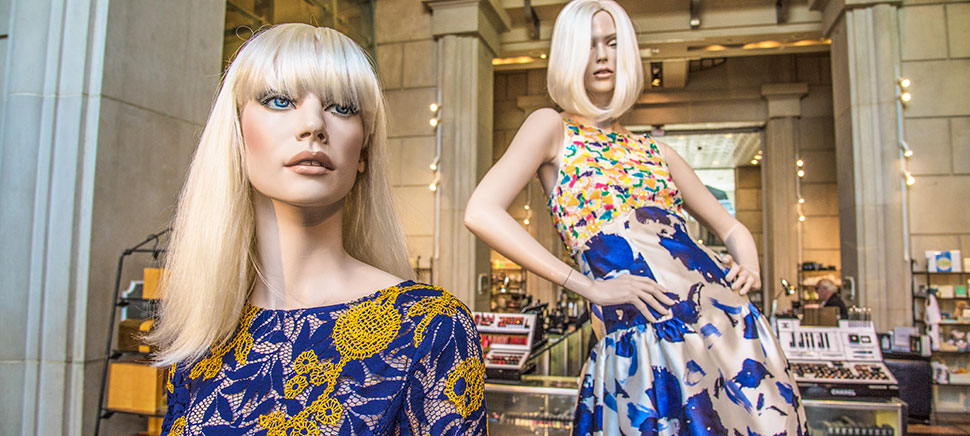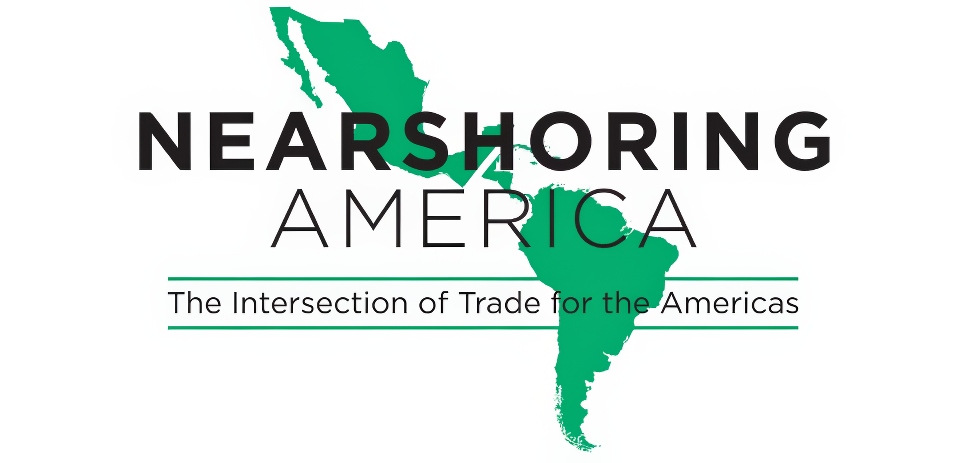While taking a drive along Dallas-Fort Worth’s major highways, it’s not hard to be taken in by the sumptuous models gracing billboards for fashion powerhouses such as Neiman Marcus, NorthPark Center, and Stanley Korshak. Their extravagant dresses, dramatic makeup, and sparkling jewels remind commuters of one thing: North Texas likes to dress up.
It’s a fact that draws back to a vision crafted by businessmen such as Herbert Marcus, Raymond Nasher, Edgar Flippen, and Hugh Prather. But it’s a legacy that continues today with digital-age, small-batch retailers sprinkled throughout the region.
CROSSROADS OF COTTON AND CATTLE
North Texas’ fashionable history traces back to the 1910s and 1920s, when Dallas—and its neighbor, Highland Park—were just beginning. Highland Park developers Hugh Prather and Edgar Flippen knew they wanted a shopping center that would serve as a town square of sorts. The concept was conceived in 1928, and by 1931, Highland Park Village was ready for customers with a filling station, a sales office, and ample retail. Even today, the 85-year-old shopping center tries to strike the perfect balance between high-end luxury and hometown retailers. “Over the past decades, numerous international brands like Chanel, Dior, Saint Laurent, Tom Ford, Ralph Lauren, and others, all of which play an enormous role in the fashion industry, have been strategically added to our collection of tenants,” co-owner and managing director Stephen Summers says.
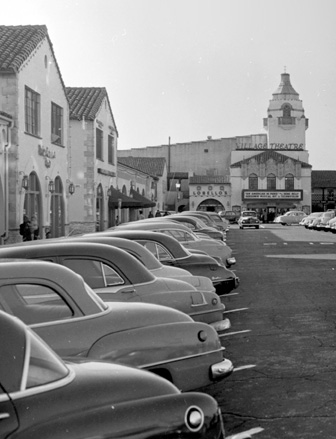
Highland Park Village in the early 1950s
Even with these larger-than-life stores, the Village has maintained a grocery store from the beginning—first Hunt’s, then Safeway, and now Royal Blue—and has kept its original Village Theatre up and running since 1935. But for most shoppers, it’s the fashion that draws them in.
“We have breathed new life into the fashion hub that Dallas is, and we continue to expand our reach,” co-owner and managing director Ray Washburne says. “Over time, the mix of tenants has continuously evolved as America’s first open-air shopping center into a place that is renowned for housing fashion’s latest and greatest cutting-edge pieces.”
As influential as it is, Highland Park Village is not the oldest icon in town. On September 10, 1907, Neiman Marcus opened in downtown Dallas at Elm Street and Murphy thanks to three people: Herbert Marcus, Sr.; his sister, Carrie Marcus Neiman; and her husband, A.L. Neiman. Just a few years later in 1913, a fire destroyed the store and it was rebuilt at its current location on Main and Ervay streets. That phoenix-like ability to rise above and continue evolving guides the institution still today.
“Neiman Marcus was founded at the crossroads of cotton and cattle,” fashion director and senior vice president Ken Downing says. “They realized early the great potential of the Southwest, shopping the globe, bringing the most superlative the three could find from around the world to the women of Dallas.”
Downing describes how Marcus’ son, Stanley—the eventual owner of the store—was “raised in the store, picking up pins in the sewing rooms, watching his father, aunt, and uncle build customer relationships, and educating the women of Dallas on the mode of the day.”
“Neiman Marcus was founded at the crossroads of cotton and cattle,” fashion director and senior vice president Ken Downing says.
Neiman’s, as it is lovingly called by locals, saw many firsts: the first Christmas booklet launched in 1926, and the women’s sportswear department opened in 1927, followed by the men’s department the following year. But in 1934, Marcus decided to run national advertisements in Vogue and Harper’s Bazaar—and he was the first retailer outside of New York City to do so.
The store’s first charity fashion show came in 1936, and in 1938, Stanley Marcus began the Neiman Marcus Award for Distinguished Service in the Field of Fashion—all before airline travel was commonplace, Downing points out. He adds that Emilio Pucci, the Missonis, and Bottega Veneta were all designers that Stanley brought to the United States. “It’s an idea that is revolutionary today, as Mr. Stanley knew early the power of celebrity in fashion,” he says.
Business only continued to grow and boom. Neiman’s opened its second store in Preston Center in 1965 and its first store outside of Texas in 1971. Eventually, the company was sold to Broadway-Hale and bought Bergdorf Goodman.
“Our collections are highly edited, with the exacting eye of a magazine editor, with our Dallas customers taste and style top of mind,” Downing says.
TRANSITIONS IN TEXTILES
The 1960s through 1980s saw major changes in Dallas’ fashion landscape. For starters, a man named Raymond Nasher leased a 97-acre cotton field. What in the world would he do with it? Build the world’s largest climate-controlled retail center. From its 1965 opening, art was a focus for the shopping center, and NorthPark Center still celebrates that history. Last year, it marked its 50th anniversary. The original anchors were Woolworths, Titche-Goettinger, JC Penney, and Neiman Marcus—because Nasher had convinced Marcus to move his Preston Center store to the new shopping destination. Today, the other three anchors have been replaced by Nordstrom, Macy’s, and Dillard’s, and the center sees about 26 million visitors a year. Nasher’s daughter, Nancy Nasher, and her husband, David J. Haemisegger, have since taken ownership.
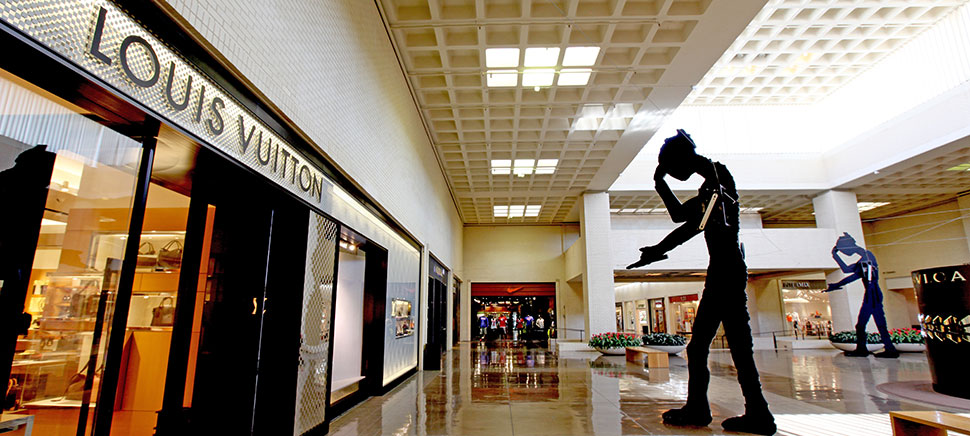
NorthPark Center
But other aspects of the Dallas fashion landscape were growing, too. Kim Dawson had started as a model and worked as a “tea-room model” in Neiman’s Zodiac Room when she settled in Dallas. Before long, Marcus was depending on her to book more Zodiac models. She quickly found herself with a business on her hands—one that her daughter, Lisa Dawson, manages today. Her move into talent management was well timed, as Trammell Crow built and opened the Dallas Apparel Mart and needed help.
“When Trammell Crow opened the Apparel Mart, he asked who could he tap to be the fashion director, and the name he heard was Kim Dawson,” Lisa Dawson says. “She said, ‘I have this fledgling modeling agency, can I bring it along?’ And she did both in tandem.”
“In the ’80s when the world started taking us more seriously, there were more opportunities to do business here.” Jan Strimple says. “People who hit the big time were more on the global stage. They gave Texas this larger-than-life persona: live loud, live large.”
Not only did Crow build a home for Dallas’ booming wholesale industry in the 1980s, Women’s Wear Daily opened a Dallas bureau. “That’s how important the market was,” fashion event producer Jan Strimple says. It was during this era that more retailers such as Albert Lidji of Lou Lattimore and Michael Faircloth—who designed Laura Bush’s 2001 inaugural gown—were able to catapult Dallas into a more international look.
“They were the voice of luxury. In the ’80s when the world started taking us more seriously, there were more opportunities to do business here. These brands gave entree to Dallas,” Strimple says. “People who hit the big time were more on the global stage. They gave Texas this larger-than-life persona: live loud, live large.”
So big, in fact, that by 1986, Dallas was ready for another powerhouse, luxury retailer. In 1909, a man named Stanley Korshak opened a store in Chicago. It lasted until the early 1980s, when the store closed and Dallasite Caroline Rose Hunt bought the rights to the name. She opened Korshak at the Crescent and hired Crawford Brock to manage it the following year. He has since purchased the store and continues to see it into the future today.
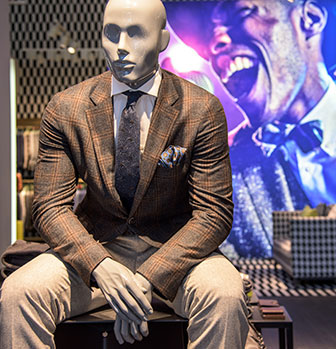
The men’s department of Stanley Korshak’s store at The Crescent.
“I hear it all the time by clients coming through here. Sometimes they’re on business trips to Dallas and they wander into here, for example, and are just blown away by what they see,” Brock says. “You multiply that by what’s offered downtown, at NorthPark, and Highland Park Village, and it’s quite an attraction.”
Brock has overseen a complete overhaul of the store in his tenure, including a focus on Italian designers and the launch of more millennial-friendly, cost-efficient, casual departments such as The Shak for men and women. That’s because he knows as extravagant and elegant as Dallas’ fashion past is, it’s moving into a more relaxed, yet still chic, direction that’s driven by a whole new generation.
THE DIGITAL WAVE
Matt Alexander, a British graduate of SMU, credits his eye for style to tagging along on his mother’s shopping trips as a child. He had also studied art for a time and dabbled in running his own website beginning in 2011. All of that culminated in his 2013 launch of Need, an online-only, highly curated collection of men’s fashion. He launched a site for women’s fashion, Foremost, the next year.
In 2014, Need was invited to co-present at New York Men’s Day (the precursor to New York Men’s Fashion Week). These ventures combined led him to develop Unbranded, a pop-up shopping concept, in collaboration with Bryan DeLuca of Foot Cardigan. The pair put on the event in Deep Ellum in 2014 and downtown Dallas in 2015. But all of this probably wouldn’t have happened if Alexander had stuck with his original plan.
“Need was originally conceived as a startup in London only—it was going to be just in the metropolitan area of London,” he recalls. “I sat down with Kevin Vela, and he was like, ‘If you do this here, you’ll be 10 times more successful than anywhere else, and I guarantee you’ll get more funding more quickly than anywhere else.’” That was compelling enough to keep him in his college town.
“Dallas is an extremely consumer-friendly city,” he adds. “It basically translates to more opportunity. It’s also sort of geographically agnostic.” Need has only recently opened up to international sales, and Alexander credits Dallas’ central location to part of that success. “The broad-stroke conclusion is that the design happens in New York, the tastes are made in L.A., but it’s bought in Dallas,” he says.
“Dallas is an extremely consumer-friendly city,” Matt Alexander says. “It basically translates to more opportunity. It’s also sort of geographically agnostic.”
That’s good news for the new crop of online retailers and fashion bloggers basing themselves out of North Texas and trying to gain national—if not international—attention. Those companies include Foot Cardigan, a subscription-based sock retailer, Hari Mari, a flip-flop retailer launched by native Dallasites, and Mizzen + Main, a line of moisture-wicking fine men’s clothes headed up by yet another SMU graduate, to name a few. Add it all up, and it means the nation is starting to notice Dallas as a fashion hot spot.
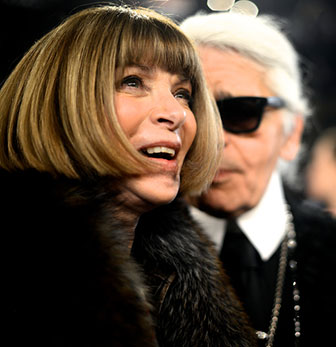
Anna Wintour and Karl Lagerfeld at the Chanel show in Dallas, 2013
“Chanel brought their pre-fall show, which is their major show, here in 2013,” fashion photographer Scot Redman says. “Every major fashion influencer in the world flew into Dallas to be there. There were only about 30 people from Dallas at the show. I do think that is an example of the powerhouse Dallas is becoming.”
And Redman and his wife, Kristi, would know. The native Dallasites and SMU grads first had a vintage clothing shop but decided to give it up to document the undergrads traipsing up and down Bishop Boulevard as if it were a runway. Their blog eventually led them to D Magazine’s StyleSheet, where they showcase all variations of street style throughout the city.
“It was a challenge for us and we just started photographing it,” Kristi says. “There are more people who dress better now, and I think a lot of that is social media, the internet, and having access to inspiration outside of just Dallas.”
In fact, Dallas has produced a slew of fashion bloggers in the last few years who are showing the world that this Southwestern city has something to offer on the sartorial front—bloggers such as Mary Summers of So Then They Say, Jane Aldridge of Sea of Shoes, Amber Venz of VenzEdits, Courtney Kerr of What Courtney Wore, and Tina Craig of Bag Snob. Even Neiman Marcus continues to think digitally with new features such as the Memory Mirror, which allows shoppers to take a peek at themselves in different outfits in a matter of seconds.
And though Dallas’ overall aesthetic has gone a little more street smart than country club in the last generation, it could be said that this digital-savvy generation is continuing what Stanley Marcus started when he placed that ad in Vogue—making the world pay attention to what Dallas can do.
“Today, Dallas is an international city of style, changing with the ever-changing ebb and flow of current trends,” Downing says.
A FASHIONABLE HISTORY
North Texas’ history in fashion spans more than 100 years.
READ MORE IN THE SERIES:
History of Innovation: The Aviation Industry
How DFW took flight as a world leader
History of Innovation: The Gaming Industry
History of Innovation: The Fashion Industry
For a daily dose of what’s new and next in Dallas-Fort Worth innovation, subscribe to our Dallas Innovates e-newsletter.










